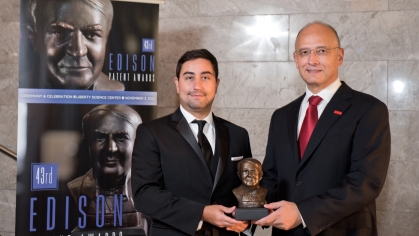SoE Hosts Transportation Infrastructure Symposium
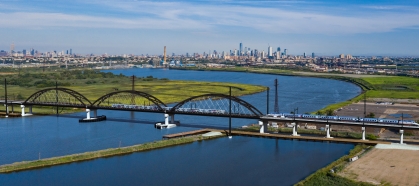
According to a recent American Society of Civil Engineers report, “substandard infrastructure costs money, jobs, and lives.” Precisely why more than 120 industry, government agency, academic leaders, and graduate students attended “Paving the Way to Meet the Future of Transportation Infrastructure,” a daylong symposium organized by the School of Engineering (SoE), the Department of Civil and Environmental Engineering (CEE), and Rutgers Center for Advanced Infrastructure and Transportation (CAIT), on May 23.
“The overarching goal of the symposium was to hear from government and industry leaders about how we are responding to some of the challenges of managing our existing transportation infrastructure – and what efforts are being made to shape its future,” says CEE department chair, professor, and symposium chair Nenad Gucunski.
He adds that the symposium also provided a forum for discussing future technology development and implementation, and “the most effective ways for government industry and academia to work collaboratively when the circumstances are right.”
A Comprehensive Presentation Program
SoE Dean Alberto Cuitiño and Rutgers Provost and Executive Vice Chancellor Saundra Tomlinson Clarke, opened the symposium with brief welcoming remarks.
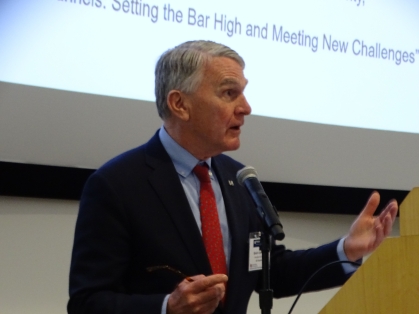
Keynote presenters included, among others: Kevin Corbett, New Jersey Transit president and CEO; Eric Daleo, Gateway Development Commission’s chief program officer; Robert Kumapley, Port Authority of NY and NJ (PANYNJ) enterprise asset management chief; Francis O’Connor, New Jersey Department of Transportation, acting commissioner; and Catherine Sheridan, president of the Triborough Bridge & Tunnel Authority.
Their topics addressed transportation infrastructure initiatives, ranging from the Hudson Tunnel project design and construction to transit planning for fans during the FIFA World Cup, to visions for shaping the future of the complex network of roadways, bridges, and tunnels in New Jersey and the New York metropolitan area.
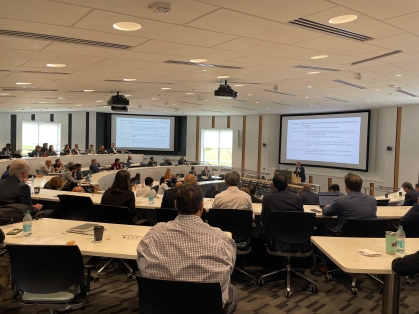
An initial technical session concentrated on alternative infrastructure project delivery methods, with Nilesh Patibandha and Thomas Kondash presenting an overview of the New Jersey Department of Transportation’s (NJDOT) design-build procurement process. Menard North America CEO Seth Perlman addressed the use of design-build for the geotechnical components of transportation facilities, while Vassilina Demetracopoulou, an assistant professor in the CEE department shared research results on the selection, risks, and paths ahead for alternative delivery methods for infrastructure projects.
A second technical session focused on infrastructure management, with Kumapley sharing lessons learned in using data standards and governance to break up infrastructure management asset silos. The session was rounded out with presentations from Harjit Bal and Kevin Sreni, who highlighted features of NJOT’s bridge and pavement management systems.
A Spotlight on Rutgers Innovations
According to Gucunski, the symposium was an opportunity to showcase transportation infrastructure-related research initiatives at Rutgers. He spoke about the use of accelerated structural testing in Rutgers’ BEAST facility to rapidly evaluate the performance of bridges and their components. Hao Wang, a CEE professor, discussed pavement management that facilitates low-carbon transportation, while CEE Associate Professor Xiang Liu summarized rail-related research and education at Rutgers. Jie Gong, a CEE professor, talked about the design of urban digital twins for safe and secure transportation modes and civic spaces.
Plotting a Path to the Future
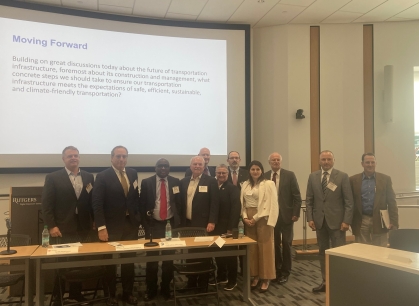
An hourlong panel discussion moderated by Malcolm McLaren, executive chairman of the board of the McLaren Engineering Group and chair of the CEE Industry Advisory Board, explored the critical role engineering innovations and government-industry-academia collaborations play in meeting today’s complex transportation infrastructure challenges.
An eight-member panel discussed both challenges and solutions in infrastructure construction and management, areas of high potential for implementing improved operation and reduced infrastructure life cycle costs, as well as how government/industry/ academic partnerships can help drive a future of positive change.
Gucunski concludes that the symposium – the fourth in a biennial series – was a tremendous success. “This was achieved in great part due to support from symposium sponsors AECOM, Halmar International, Kiewit, Langan, McLaren Engineering Group, Michael Baker International, and WSP.”


